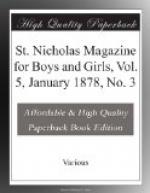[Illustration: FIG. 1. THE PATHS OF MARS AND SATURN.]
The actual paths traveled among the stars by these two planets, this fall, are shown in Fig. 1. You will see how wildly the fiery Mars, the planet of war, careers round his great loop, while old Saturn, “heavy, dull, and slow” (as Armado says that lead is—the metal dedicated to Saturn), plods slowly and wearily along. Between August 6 and October 1, Mars traversed his entire backward track,—Saturn, you notice, only a small portion of his much smaller loop. On the sky, too, you will see that while Mars shines with a fierce ruddy glow, well suited to his warlike character, Saturn shines with a dull yellow light, suggestive of the evil qualities which the astrologers of old assigned to him. “My loking,” says Saturn, in Chaucer’s “Canterbury Tales,” “is the fader of pestilence:
“Min ben also the maladies colde,
The derke treasons, and the costes olde;
Min is the drenching in the see so wan,
Min is the prison in the derke cote,[1]
Min is the strangel and hanging by the
throte,
The murmure, and the cherles[2] rebelling,
The groyning and the prine empoysoning.”
[Footnote 1: Dark
or gloomy coast. This line was amusingly
rendered, by the printer of
my “Saturn and its System,” in which I
quoted Chaucer’s lines,
“Mine is the prison, and the dirty coat.”]
[Footnote 2: Churl’s. Notice this word. It is the same as the word rendered Charles’s in the common English name for the Dipper. One should always say Charles’s Wain, not Charles’ (as is the way Tennyson does in the “May Queen “).]
For the present, however, let us consider the planet Mars, leaving slow Saturn to wait for us another month.
It has always seemed to me one of the most useful lessons in astronomy to follow the line by which, long ago, great discoveries were made. Thus, if the young reader went out on every fine night and noted the changing position of Mars, he traced out the track shown in Fig. 1. He noted, also, that the planet, which shone at its brightest about September 5, gradually grew less and less bright as it traveled




